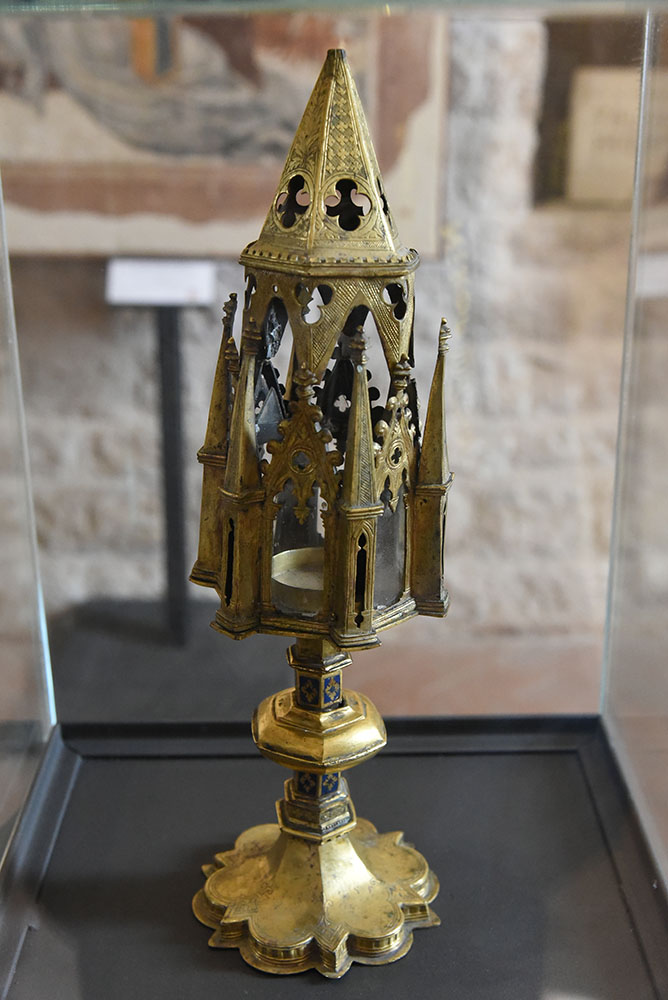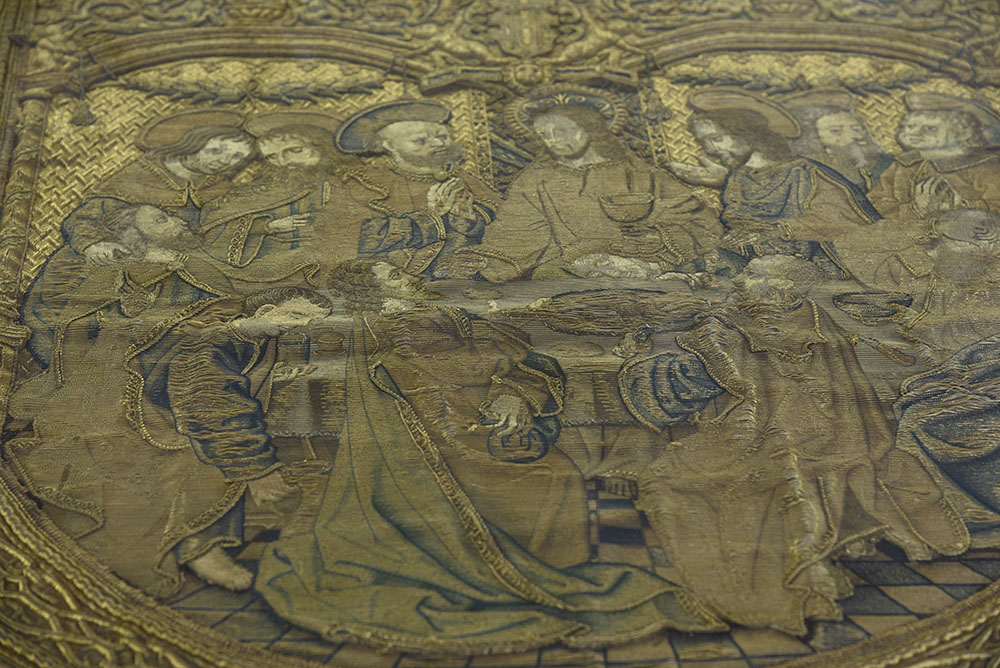Umbria is a land of centuries-old sacred splendours that bring back today the intact and uncorrupted splendors of the past in art.Through the vivid historical, artistic and architectural testimonies of the Umbrian towns, it is possible to find an itinerary made up of places, sacred objects, works of art and traditions that closely interact with the territory. They bring back to us the entire influence and greatness that the church had on the artistic production and craftsmanship of the past in a unique language. The Diocesan Museum of Gubbio, is an absolute unicum in this context of splendour, thanks to the architectural context and its collections, linked to the centuries-old history of the Diocese of Gubbio. The part related to the goldsmith collection stands undoubtedly out among all the others. The three treasure rooms house some ancient assets of the diocese, including mitries, cope clasps, crosses, rings and other bishop’s jewels, an impressive collection of chalices, chirotheques, pontifical shoes, pastoral curls and a portable tabernacle. The three treasure rooms also include objects for the celebration of the Eucharist, censers, a begging plate for the offertory, various statue jewels and a rosary of our Lady of Sorrows along with some reliquaries in different forms. Another interesting testimony of liturgical art in Gubbio are the two cross-shaped reliquaries coming from Saint Francis Church, where they were found in 1910. They are visible in Palazzo dei Consoli. The reliquiaries feature captions of the relics kept inside and vegetal motifs. Saints are visible inside the mixtilinear terminals and in the middle of the cross. A cross shows Christ in Pietà, the Virgin Mary, Saint John the Evangelist, Saint Peter and another Saint The other cross shows St. Francis, the Virgin Mary and St. John the Evangelist, The Redeemer conferring a blessing on the front while St. John the Baptist with the Lamb, St. Anthony of Padua and St. Clare are on the back. The third stage of the development in this type of fourteenth-century Umbrian products stands out in these crosses where a significant leap in quality compared to the previous phases and direct derivation from figurative sources exclusively from Assisi distinguish this third stage. The two reliquaries are in fact part of a group of devotional furnishings that critics have considered to have the style of Puccio Capanna, one of Giotto’s main disciples who created characters having a deep sentimental and psychological intensity. The artistic experiments of Capanna are masterfully received by the author of the engraved glasses. He was able to recreate the plastic substance of characters described by a soft chiaroscuro within a very clear and firm contour line. These artifacts had Assisi and Umbria as a place of production and spread Another shrine contains precious pyxes, monstrances and Pax liturgical objects. Another one is full of silver Altar cards, containing the texts of the masses that were placed on the altar during the celebrations. A humeral veil dating back 1800 that the priest leaned on his shoulders completes the itinerary. The territory of the Apennines with its small and large municipalities, bears in itself similar but at the same time different testimonies. The several testomonies related to sacred art and to liturgy in the Rocca Flea Civic Museum in GualdoTadino are an example: the processional double face banner by Matteo Da Gualdo, showing our Lady of the Assumption and the Immaculate Conception, coming from the parish church of Santa Maria di Nasciano. The two faces underline the exceptional nature of the figure of Mary, with the Assumption into heaven and the Immaculate Conception.The latter is particularly interesting, as it is an early depiction of the the Virgin. Also attributable to the hand of Matto da Gualdo is Mary Enthroned with Christ and the Saints, coming from the monastery of the Poor Clares of Santa Margherita. The iconography emphasizes the Franciscan order: Mary Enthroned with Christ are in the centre while St. Francis and St. Bernardine are on the left and St. Margaret and St. Catherine on the right; St. Bonaventure and Ludwig of Toulouse are in the in the two roundels of the cymatium.The altarpiece is the first dated work by Matteo da Gualdo. Also undoubtedly worth mentioning is the Maestro del Crocifisso da Gualdo with a crucifix coming from the first urban church of the Franciscans, consecrated in 1315. The iconography is that of Byzantine origin of Christus patiens, which replaced the older one of Christus triunphans.
The cross of Gualdo belongs to the culture of northern Umbria and fits perfectly into the development generated by the great hotbed of Assisi. There are also various liturgical vestments, such as those in the shrine in the centre of the ancient Church of Sant’Angelo de Flea, mentioned in the 12th century and which constitutes the original nucleus of the Rocca. Other examples of liturgical vestments are on display and are supposed to come from the Chapel of St John the Baptist located in the same place. Continuing along this route, we arrive in Nocera Umbra, where the local Diocese has an uncertain but very ancient history. It could certainly be traced back to the 5th century, despite the absence of documents, present only from the 10th century. At that time it acquired the lands of the former dioceses of Plestia and GualdoTadino and extended until Sassoferrato. One of the most important places is the Convent of the Franciscan Tertiaries. From the end of the 15th century, a hospital was annexed to the monastery and the provisions of the Council of Trent imposed cloistered life to the nuns. The church attached to the convent was rebuilt in the 17th century and took the name of San Giovanni dellaSportella. In a single hall there are three altars in Baroque style, a triumphal, extravagant, almost theatrical style. The central altar has a rich frame of carved and gilded wooden architectural elements, and the ensemble ends with a solemn cymatium supported by puttos and festoons. Equally interesting is the Church of Saint Lucy, a small church telling a long story, as shown by its architecture with a pointed arch door in square stone, possibly dating back to the 14th century. The church is located in Aggi and it is richly decorared with frescoes; a stone with a Gothic cross is carved in the arch. All these testimonies are a unique itinerary to be experienced and explored, bringing us in close contact with the historical influences of ecclesiastical patronage in these lands.
SACRED ART ITINERARYeuristica2021-04-01T09:40:09+00:00




